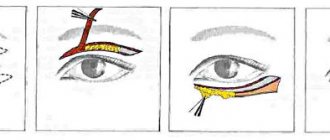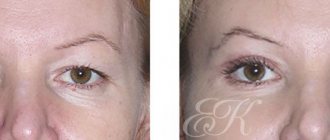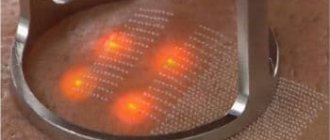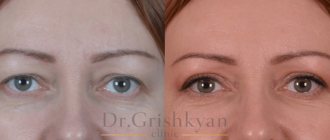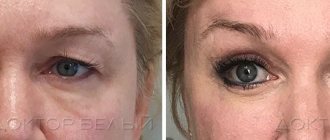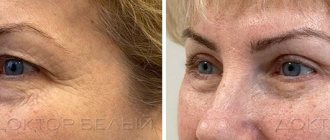Blepharoplasty is a plastic surgery that allows you to correct the shape of the eyes, remove drooping eyelids and bags under the eyes. Many women resort to such surgical intervention; the procedure is quite simple, easily tolerated, but requires effective pain relief. Anesthesia for blepharoplasty can be general or local; what type of anesthesia will be used depends not only on the patient’s personal preferences, but also on the volume of the operation, associated disorders, tolerance of painkillers and a number of other conditions.
Types of anesthesia used for blepharoplasty
Blepharoplasty involves removing fat deposits and tightening muscles through incisions in the skin. Naturally, such manipulation is accompanied by severe pain, so it is impossible without high-quality pain relief. Blepharoplasty can be performed under local or general anesthesia:
- Local anesthesia is local anesthesia of the skin and subcutaneous fat in the affected area. That is, the introduction of a local anesthetic temporarily disables pain receptors specifically in the eye area, and allows operations to be performed without general anesthesia;
- General anesthesia. This term refers to the intravenous or inhalational administration of anesthetics, leading to inhibition of the central nervous system, as a result of which pain sensitivity disappears, muscles relax, reflex reactions are suppressed and consciousness is turned off. The use of modern drugs allows you to select a dose that has minimal negative effects on the body and its effect lasts exactly as long as necessary for the operation.
Local anesthesia is often combined with sedation - the administration of sedatives. Their use slows down the functioning of the central nervous system, but at the same time the person being operated on is conscious.
Evgeniya
Igor Anatolyevich! Thank you very much for your talent, patience, and work! Believe in me...for my results...for a new young look! There are no words - I’m still so delighted! Strength to you and to even more happy patients like me))) After lower blepharoplasty, I began to have a second youth, those around me say that I began to look like I did 10 years ago!
What to choose - general or local anesthesia
What anesthesia is required for blepharoplasty? It is better to choose the type of anesthesia together with your doctor. Most patients prefer local anesthesia, but you need to know that such anesthesia is only possible if the correction concerns only the lower or upper eyelid. With such an intervention, the volume of the operation is insignificant and not particularly complex in terms of technique, so local anesthesia will allow the plastic surgery to be carried out efficiently.
Most doctors even prefer to combine local anesthesia with sedation, since this puts the patient into a shallow sleep, therefore relaxes and does not interfere with the doctor’s eyelid surgery.
General anesthesia is definitely used if circular blepharoplasty is necessary - simultaneous correction of the lower and upper eyelids, changing the shape of the eyes. Such an intervention requires more time and full concentration of the surgeon, and the effect of local anesthesia to comply with these conditions is insufficient. When choosing an anesthesia option for blepharoplasty, not only the type of correction is taken into account, but also a number of other conditions:
- Patient's age;
- Psycho-emotional status. For people with a high level of anxiety, neuroses, suspiciousness and doubts, general anesthesia is recommended, since with local anesthesia there is a high probability that they will constantly distract the surgeon, which will not have the best effect on the quality of blepharoplasty;
- Tolerance of local anesthetics. A number of patients are allergic to drugs from this group, so they are indicated for general anesthesia;
- Diagnostic data. Before blepharoplasty, an extensive examination is required; it is also necessary to identify indications and contraindications for anesthesia.
Any anesthesia requires preparation of the patient, so the type of anesthesia is selected in advance.
Preparatory stage
Preparing a patient for blepharoplasty involves conducting a number of examinations, these are:
- Blood test, including blood clotting, sugar, infections;
- Fluorography;
- ECG – electrocardiogram of the heart.
Consultation with an ophthalmologist and anesthesiologist is required. If general anesthesia is necessary, permission from a physician or cardiologist will be required. For the operation itself to be successful and for no negative consequences to arise, the following is required:
- At least 3 weeks before surgery, stop smoking, drinking alcohol and using blood thinners;
- Compliance with diet therapy on the eve of blepharoplasty. The day before surgery, preference should be given to easily digestible foods; in the morning before surgery, you should not eat or drink.
The patient should be warned in advance about the type of anesthesia chosen, the characteristics of its effect on the body and the condition after the operation.
Blepharoplasty
Blepharoplasty (or eyelid surgery)
is considered one of the most common operations around the world.
And this is not surprising - when communicating with an interlocutor, we first of all pay attention to his eyes. And if there are “bags” under the eyes, excess skin, and the upper eyelids droop, such a face gives the impression of being tired, sleep-deprived and, ultimately, older. The eye area, or periorbital region, is an independent anatomical and topographical unit with its own special biomechanics. Of course, it cannot be considered in isolation from the entire face. But often even small changes to the upper and lower eyelids can dramatically improve the appearance of your face.
Currently, there are only four main types of blepharoplasty: Upper blepharoplasty, Lower classic blepharoplasty, Lower transconjunctival blepharoplasty, Deorientalizing blepharoplasty (or Europeanization of the eastern eyelids).
Indications.
The operation is performed in case of excess skin of the upper and (or) lower eyelids, sagging skin, the appearance of fine wrinkles on the lower eyelids, drooping of the lateral corner of the eye, and the appearance of “bags” under the eyes. If there is severe excess, the skin of the upper eyelid may even partially cover the lateral (outer) edges of the palpebral fissure, interfering with vision.
Upper blepharoplasty
can be done under local anesthesia, since there is practically no pain during the operation itself. Traditionally, the most unpleasant moment of the intervention is anesthesia, but the sensations at the time of its implementation are approximately the same as during filler injections, biorevitalization and other injection procedures.
Surgery on the upper eyelids involves identifying and removing excess skin and so-called “fatty hernias” - accumulations of fatty tissue in the area of the inner corner of the eye and the central part of the upper eyelid. Often these manipulations are complemented by the removal of a thin strip of the orbicularis oculi muscle to create a clear palpebral groove (natural fold of the upper eyelid)
Lower blepharoplasty
is indicated for patients with excess skin of the lower eyelids, weakness of the orbicularis oculi muscle, which, together with excess fatty bags, leads to the appearance of so-called “bags under the eyes” and a tired facial expression. The operation is performed through a thin incision under the ciliary edge of the lower eyelid, carefully peeling away the skin and exposing the orbicularis oculi muscle. During the detachment process, it is very important not to disrupt the blood supply to the skin, preserving the thinnest intradermal vessels, so I always perform lower blepharoplasty under optical magnification. After exposing the orbicularis oculi muscle, it must be strengthened, and excess fat bags must be sparingly removed.
Transconjunctival lower blepharoplasty
preferred in patients with pronounced excess fatty bags of the lower eyelids (so-called “fatty hernias”) in the absence of excess skin - as a rule, this situation occurs in younger patients.
Deorientalizing blepharoplasty
performed to correct the epicanthus (folds of skin at the inner corner of the eye) and create the so-called. palpebral fold (fold of the upper eyelid, characteristic of “European” eyes)
Contraindications.
There are no specific contraindications to the operation. General contraindications include local acute inflammatory diseases (conjunctivitis, blepharitis, barley), acute colds, somatic pathologies affecting blood clotting (hemophilia), arterial hypertension, systemic connective tissue diseases (primarily systemic vasculitis), etc.
It is also important to note that eyelid surgery does not impair vision because... During the intervention, only the soft tissue structures of the orbit are affected, and not the eyeball.
Preparation.
The operation does not require special preparation.
At the preliminary consultation, we discuss your wishes for the new appearance of your eyes, the duration of the operation and recovery. I will definitely show you the results of my work and we will try to imagine what your eyes will look like after the operation.
At the end of the conversation, we choose the type of anesthesia (local or general), talk about your health, previous diseases and existing allergic reactions. This conversation determines the scope of the preoperative examination. For local anesthesia, in most cases it is necessary to undergo an abbreviated blood test. The operation, performed under general anesthesia, requires extensive testing, including electrocardiography (ECG) and chest x-ray.
Special recommendations: 2-3 days before surgery you should stop using eye makeup (mascara, eye shadow, etc.)
On the day of surgery.
Blepharoplasty is always performed in an operating room. On the day of the operation, you are admitted to the hospital ward. Before the operation, we always meet again, take photographs, and after a short preparation we meet in the operating room.
After the operation under local anesthesia, you will be immediately transferred to a hospital room. After general anesthesia, you will be transferred to the intensive care unit for a while under the supervision of an anesthesiologist.
The first hours after surgery must be spent in the hospital for observation.
Recommendations and recovery.
On the first day after surgery, strict bed rest is indicated. For the first 2 days after the intervention, it is recommended to apply a cold compress to the eye area 3-4 times a day for 15-20 minutes. This is necessary to prevent hematomas and reduce tissue swelling.
Removal of sutures and main stickers - 3-4 days after surgery. After this, the seams must be covered with thin stickers for another 2-3 days.
Lower transconjunctival blepharoplasty is performed without stitches, so the main stickers can be removed already on the 4th day.
You can wash your face and apply moisturizing eye cream after 6-7 days. You can start using eyelid cosmetics two weeks after surgery.
FAQ.
—
How often do men undergo blepharoplasty?
– More often than you might think! Modern socially active men pay quite a lot of attention to their appearance, because a fresh, well-groomed face is perceived by the interlocutor as an indicator of success. Upper blepharoplasty in men has its own characteristics, for example, the incision on the male eyelid should be shorter.
—
What other restrictions exist after surgery?
– Limiting physical activity (lifting weights more than 2-3 kg, playing sports) for 3-4 weeks, avoiding air travel for 1 week, avoiding thermal procedures (hot bath, sauna, steam bath) for 3-4 weeks after surgery.
—
When can you go to work?
– If your work does not involve physical activity, then within a week.
—
How long does the swelling last?
– As a rule, maximum swelling after surgery is observed on days 3-4. After this, over 12-14 days the swelling gradually decreases and becomes almost invisible to others. Residual effects (minor swelling in the morning, after taking a large amount of liquid, etc.) can appear for up to 2 months.
—
How to deal with scars?
– Usually scars after any intervention are completely formed within 5-6 months. During this time, the visible reddish scar gradually lightens and after 2-3 months disappears into the fold of the eyelid. In some cases, I can recommend you a special anti-scar gel. As a rule, after six months the scar after blepharoplasty becomes almost invisible.
Features of local anesthesia for blepharoplasty
Pain sensitivity during local anesthesia is turned off in two ways:
- Application - cream is applied to the desired area of the body or gel with anesthetics is sprayed;
- Injection - the anesthetic is injected under the skin using a syringe with a needle.
Blepharoplasty under local anesthesia is performed after injection of drugs. The application method is not used for this type of plastic surgery, since external agents do not penetrate deeply and therefore do not affect the subcutaneous fat. In most cases, injection anesthesia is performed with drugs containing ultracaine, lidocaine, and buvicaine.
Elena
All my life I took the bags under my eyes as a given, then I went to a cosmetologist (I wanted to inject Botox or fillers), she said that the bags in my case can only be removed surgically and advised I.A. Bely.
I started reading reviews and forums on the Internet, made a list, called clinics, found out prices and the methods that surgeons use during operations, signed up for consultations, and during consultations asked to show me photographs of patients to see the results of the work. I asked the doctors questions that concerned me, and thus I chose my surgeon, who was initially recommended to me by my cosmetologist (Igor Anatolyevich) and was not mistaken. Thank you very much for my new eyes! You can sign up for an in-person consultation and find out the price for the lower eyelid blepharoplasty procedure online, or by phone5 or write to messengers: or.
Advantages and disadvantages
Blepharoplasty under local anesthesia is preferable to general anesthesia. The main advantages of such pain relief are:
- Slight risk of developing systemic severe complications, possible due to the toxic effects of drugs used during general anesthesia;
- Ability to follow physician orders. During the operation, the surgeon may ask the patient to periodically close and open his eyes, which has a positive effect on the results of the correction;
- Short rehabilitation period after anesthesia. The patient can be under the supervision of clinic staff for only 2-3 hours, and then he is sent home.
Despite the obvious advantages of local anesthesia for blepharoplasty, this type of anesthesia is not always used. Its disadvantages are:
- Possible increase in blood pressure. During plastic surgery on the eyes, most patients are nervous, which often leads to increased blood pressure. This condition does not threaten health, but increases the risk of bleeding, which complicates the surgeon’s work;
- Risk of allergic reactions to the anesthetic used;
- Inability to use local anesthesia for extensive surgery. Most often, local anesthesia is prescribed for upper eyelid blepharoplasty. When correcting a defect in the lower part, the incision is made from the inside and this is not always possible if the operated person is conscious.
Stages of surgery under local anesthesia
Blepharoplasty under local anesthesia is carried out in several stages:
- The doctor uses a special marker in the area of intervention to mark areas that need correction;
- The skin is treated with an antiseptic;
- Local anesthesia is performed;
- After turning off pain sensitivity, the surgeon proceeds directly to blepharoplasty.
The duration of the procedure is about 40 minutes, sometimes a little more or less. During this time, the anesthesia will remain in effect. But if pain occurs, you must immediately inform your doctor about it - additional administration of the medicine again blocks pain receptors.
Feelings during blepharoplasty under local anesthesia
There is no pain during eye and eyelid correction under local anesthesia. However, the person being operated on is conscious and may experience some discomfort:
- When the injection is administered, quite severe pain is felt, but it lasts literally seconds and this time must be endured;
- Pressure on eyelids from using instruments. At this time, complete calm is required from the patient, since both the quality of blepharoplasty and the absence of complications after the operation depend not least on this;
- Stinging in the eyes from bright surgical lights. During upper eyelid surgery, the eyes are closed, but sometimes the surgeon may ask them to open, and temporary blindness may occur when looking at a bright light source located opposite;
- Nervous tension, which can cause tachycardia, excessive sweating, weakness, and fainting. If the patient is predisposed to such mental changes, then it is better to use local anesthesia along with sedation.
There is no pain for about 1-2 hours after blepharoplasty, but then pain may appear. If their intensity is high, you can take a painkiller recommended by your doctor.
Possible complications of local anesthesia
The most dangerous thing that can happen with local anesthesia is an allergic reaction, which in severe cases can lead to anaphylaxis and angioedema. Fortunately, such complications occur extremely rarely. The development of Quincke's edema and anaphylaxis requires immediate medical assistance. Therefore, blepharoplasty should be done only in those clinics whose offices have a first aid kit for emergency care, and in the institution itself there is an intensive care unit.
Other complications of local anesthesia include:
- Impaired spontaneous breathing. This complication occurs in people with severe pathologies of the respiratory system, but usually any local anesthetics are contraindicated for them, so the diagnosis must be carefully carried out;
- Formation of hematomas due to puncture of a vessel at the time of injection. The complication is not dangerous, the bruising goes away within a few days;
- Infection. The ingress of pathogenic microorganisms at the time of injection is possible if the rules of asepsis and antisepsis are not followed.
Blepharoplasty under local anesthesia does not lead to undesirable complications if all indications and contraindications are fully established before the procedure, and the surgeon strictly follows the technique of administering the injection and performing plastic surgery.
Recommendations after blepharoplasty
The procedure is performed on an outpatient basis and after 1-2 hours you will be discharged from the hospital. If a facelift was performed at the same time, hospitalization for 2-3 days may be recommended.
You can return to your normal lifestyle immediately after discharge from the hospital. However, it is better to ensure maximum rest for yourself during the first 24 hours. After the operation there will be pain, which is eliminated with the help of painkillers. In order to quickly get rid of bruises and swelling, cold compresses are recommended.
During the first three days, eye drops, decongestant and disinfectant ointments are used. It is recommended to sleep on a high pillow. Limit the amount of salt in the diet.
During the week, try not to strain your eyesight by reading, watching TV, doing handicrafts or working on a PC. During this period, also do not wear contact lenses or use cosmetics. Wear sunglasses when going outside, and give up smoking and alcohol.
To speed up the healing process, the doctor may prescribe physical therapy. The stitches are placed in natural folds and along the eyelash line, so they are practically invisible even upon close examination. If access was through the inner surface of the lower eyelid, then there are no stitches at all. Complete healing occurs after a month - only then can you resume sports training and thermal procedures, such as baths and tanning.
Blepharoplasty under general anesthesia
General anesthesia can be intravenous or inhalational. When performing blepharoplasty, preference is increasingly given to TIVA anesthesia - a modern method of turning off consciousness. The abbreviation TIVA stands for total intravenous anesthesia, which uses only a mixture of drugs injected into a vein. Inhaled drugs to inhibit central nervous system are not used with this type of anesthesia. The main advantages of TIVA anesthesia:
- There is a slight likelihood of nausea and vomiting after anesthesia;
- Hemodynamic stability of the patient;
- Lowest risk of toxicity for the patient;
- Reduced pressure inside blood vessels;
- Fast recovery period after surgery.
TIVA anesthesia provides automatic administration of a pre-calculated dose of anesthetics and continuous monitoring of the patient's condition. Total intravenous anesthesia can also be used if the patient has a persistent form of arterial hypertension.
General anesthesia, unlike local anesthesia, ensures complete relaxation of the muscles and switches off the patient’s consciousness, which allows the doctor not to be distracted during blepharoplasty by factors unrelated to the course of the intervention. After general anesthesia, the likelihood of systemic adverse reactions is high. But their development depends mainly on how correctly the dose of the drug is selected. When calculating it, the patient’s weight, age, and the presence of concomitant diseases are taken into account. Therefore, only a qualified anesthesiologist can give high-quality anesthesia.
Reviews of circular blepharoplasty under general and local anesthesia
Olga, 50 years old “I had blepharoplasty performed under general anesthesia with sedation. My consciousness was foggy, that is, I perceived the staff’s conversations and their actions as if from the outside. There was no pain or discomfort, and the procedure itself went quickly for me. After the end of the operation I felt lethargic for some time and had slight dizziness, then everything returned to normal. I am quite satisfied with the effect of blepharoplasty, as well as the pain relief; after a few days I no longer felt any negative reactions from the plastic surgery.” Marina, 44 years old “5 years ago I decided to have blepharoplasty. The question immediately arose: under what anesthesia should the operation be performed? A friend recommended local anesthesia. And what I want to tell you is that it was no more painful than at the dentist, and the consequences of general anesthesia were avoided.”
Where to get lower blepharoplasty done in Moscow?
Such operations are quite popular and are carried out in many clinics, but it is always important to find not just a performer who can perform this or that operation, but a truly professional in his field.
Doctor Bely is rightfully considered a master of blepharoplasty in Moscow. He has over 20 years of experience in the field of plastic surgery. Every year, Igor Anatolyevich performs more than 1000 operations and every day pleases his patients with high-quality results.
If you want to tighten the skin of your lower eyelids, smooth out wrinkles and get rid of bags under your eyes, then visit a face-to-face consultation with Dr. Bely. You can sign up online or by phone5 or write to messengers: or.

